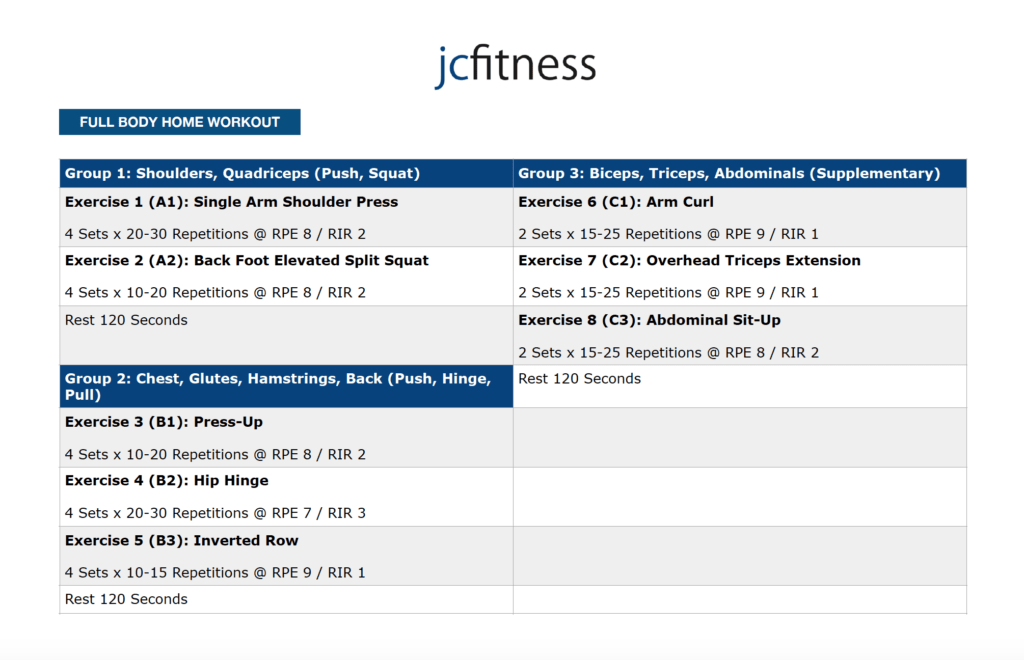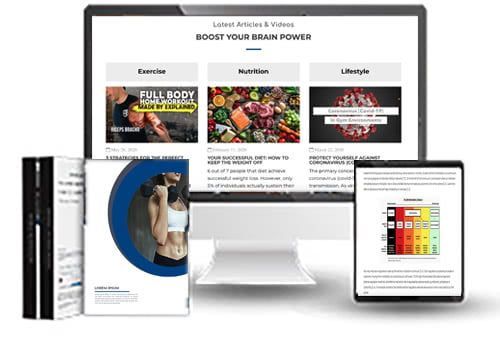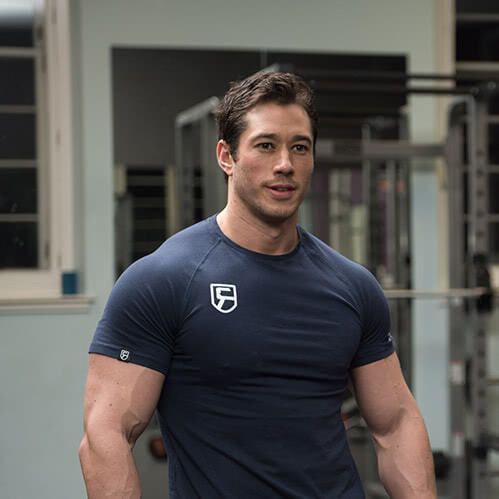
YOUR FITNESS BLOG
3 Strategies For The Perfect Home Workout
A well-designed home workout is reliant upon manipulation of exercise variables to accelerate the desired muscular adaptation (i.e. muscle growth, strength, endurance). As discussed in a previous article, these exercise variables include both quantitative variables, such as repetitions, sets, resistance, frequency and tempo, as well as qualitative variables, such as exercise selection [8]. The purpose of manipulating exercise variables for home workouts carries the same aim as in gym workouts: to create overload to force the body’s systems to adapt, thereby making improvements in the desired adaptation [5].
Importantly, manipulating exercises variables should be tailored according to individual requirements as research shows that individual response to the same exercise routine vary considerably between individuals [2]. To maximise the effects of a home workout, a number of strategies can be applied to improve workout individualisation and enhance motivation to exercise. This article discusses 3 specific strategies including individualising home workouts, structuring workouts, and recording progress.
1. Reflect Your Objectives
First and foremost, a home workout should reflect the desired adaptation. In the context of muscle development (hypertrophy), exercises should be organised in hierarchal order that prioritise muscles of greatest interest [4]. For example, an individual interested in developing the quadriceps (front thigh) muscles should prioritise exercises that target these muscle early in the workout. Research shows that the performance of multi-joint exercises (i.e. squat, shoulder press, chest press) significantly decline when completed later in a workout following multiple exercises that stress the same muscle groups [4]. Therefore, placing these exercises early in the workout, ensures they can be completed with less fatigue, greater rates of force output, higher number of repetitions, and great amounts of weight [4].
Total volume (repetitions x sets x load) is shown to be a powerful driver of muscle growth [6]. As total volume is typically described per muscle group, per week period, assigning a weekly total volume to prioritised muscle groups is important for maximal results. Selecting the amount of volume per muscle is highly individual [6, 7]. For untrained individuals, research shows that performing 2 sets per major muscle group (i.e. legs, shoulders, back) is more beneficial compared to 1 set [6]. However, for trained individuals, multiple sets, 20 sets or greater, per major muscle group, have been suggested [6].
To maximise development of targeted muscles, weekly volume should favour these muscles over others. Therefore, attention should be given to assigning more volume to prioritised muscles groups [4]. This can be achieved through manipulation of different variables, including increasing the number of repetitions, sets, exercises, or training frequency for targeted muscles. For structuring a home workout, distributing total weekly volume about equally across individual workouts through the week will help to facilitate recovery between workouts and ensure higher quality of sets within each workout. For example, if the selected total number of weekly sets for quadriceps is 20 and an individual performs 3 workouts per week, volume can be distributed across the three days (i.e. Monday 7 sets, Wednesday 7 sets, Friday 6 sets).
2. Structure Your Home Workout
Structuring your home workout can help build effectiveness and efficiency into your exercise. A structured home workout organises exercise variables (i.e. exercises, exercise order, sets, repetitions, rest intervals) into a plan prior to a workout, as opposed to selecting these variables during a workout (see Full Body Workout design below). This can help make your workouts more efficient as the duration of your home workout is dictated by your plan, not by arbitrary time selection.
Also, as progression towards the desired adaptation is strongly determined by careful manipulation of exercise variables, structured workouts allow for more objective programming changes to be made over time, which can be valuable for understanding the impact of your workouts. Periodisation, defined as the planned manipulation of exercise variables in order to maximise a specific training adaption (i.e. muscle growth, strength, endurance), can be helpful in making methodical improvements in the desired goal, while minimising fatigue or overtraining [5].

Periodisation is based on the General Adaptation Syndrome (GAS), a model that states that systems (i.e. human body), will adapt to any stressors (i.e. exercise) imposed upon it to meet the demands of these stressors [5]. Without changes in overload, there simply is no need for the body to adapt and progress will cease. A periodised or planned workout program can help avoid this issue by changing the exercise variables to force adaption [5].
3. Record Your Progress
With progress being one of the greatest motivators in exercise, it’s no surprise that as personal trainers, we record the workouts of our clients to assess exercise progression to enhance motivation. As humans, we are hard-wired for productivity because of the immediate satisfaction it brings [3]. When goals are achieved, the brain releases dopamine, a neurotransmitter that gives feelings of pleasure and contributes to enhanced motivation, memory, and attention. Research conducted by behavioural scientist Francesca Gino showed that individuals who recorded and completed small tasks felt the highest level of motivation and job satisfaction compared to individuals who did not complete small tasks [3]. Gino noted that completing smaller tasks, as opposed to larger goals, creates a positive feedback loop that, in turn, enhances motivation to work hard moving forward [3].
Recording your home workout begins with selecting a workout tracker. This can be a digital tracker or simple notebook. Whichever form, it should be quick and easy to use. Depending on your objective(s) it is highly beneficial to indicate baseline figures in your workout tracker. These can be bodyweight, circumference measurements, and/or skin fold calliper measurements for body composition objectives like weight loss. For strength, recording load is relevant and for muscle growth (hypertrophy) recording total volume (repetitions x sets x load). Workout records can be detailed or simplified, but should, at an essential level, indicate the exercise, load and number of repetitions and sets performed.
Here is a simple 3 steps process for creating effective workout tracking:
Step 1: Record the date and time of the home workout at the top of the page or screen.
Step 2: Outline the home workout to be performed using the following template:
[Exercise] – [Load] – [Sets] x [Repetitions]
Set 3: Write relevant notes that will help indicate progression for your next workout. For example, indicating that you will transition from kneeling incline press-ups to kneeling standard press-ups next workout, or that another set will be performed in a specific exercise.
Summary
Making progress in home workouts requires a basic understanding of the fundamental principles of exercise. The principle of overload is based on the GAS model, which states that the body adapts to exercise and overload is required to ensure adaption continues [5]. In home workouts, the aim should be manipulate exercise variables to create overload and force adaption [8]. The principle of individualisation states that manipulation in exercise variables should be adjusted according to individual needs [8].
Given this, your home workout should be designed and adjusted to maximise your response in line with your objectives. Structuring and recording your home workouts are simple and effective strategies that can be used to make objective changes to your exercise programming that translate into better results. Tracking workouts can also help to enhance motivation in home workouts by revealing progress over time. This is relevant as research indicates that motivation is linked to exercise adherence, where adherence is a critical factor in determining goal attainment [1].
For more information on our personal training services please click here to read more.
References:
[1] Baz-Valle, E et al. 2019. The effects of exercise variation in muscle thickness, maximal strength and motivation in resistance trained men. Vol. 14, No. 12. PLoS ONE.
[2] Bamman, M, M. et al. 2017. Cluster analysis tests the importance of myogenic gene expression during myofiber hypertrophy in humans. June. Vol. 102, No. 6. pp. 2232-2239. Journal of Applied Physiology.
[3] Gino, F. and Straats, B. 2016. Your Desire To Get Things Done Can Undermine Your Effectiveness. Harvard Business Review. Taken From: https://hbr.org/2016/03/your-desire-to-get-things-done-can-undermine-your-effectiveness.
[4] Hoffman, J. R. 2012. NSCA’s Guide to Program Design. Utilise Proper Workout Structure and Exercise Order.
[5] Lorenz, D. and Morrison, S. 2015. Current Concepts in Periodisation of Strength and Conditioning for the Sports Physical Therapist. November, Vol. 10, No. 6, pp. 734-747. International Journal of Sports Therapy.
[6] Schoenfeld, B. J. 2017. Dose-response Relationship Between Weekly Resistance Training Volume and Increases in Muscle Mass: A Systematic Review and Meta-Analysis. June. Vol. 35, No. 11, pp.1073-1082. Journal of Sports Sciences.
[7] Schoenfeld, B. J. 2016. Science and Development of Muscle Hypertrophy. Champaign, IL. Human Kinetics.
[8] Zatsiorsky, V. M. and Kraemer, W. J. 2006. Science and Practice of Strength Training. Champaign, IL. Human Kinetics.

Did you find this content valuable?
Add yourself to our community to be notified of future content.

